Is the Red Sea Sea-Level Rising at a Faster Rate than the Global Average? An Analysis Based on Satellite Altimetry Data
Abstract
:1. Introduction
2. Materials and Methods
2.1. Data
2.2. Methods
3. Results
3.1. Comparison of Altimetry Data against Tidal Data
3.2. Annual Mean Climatology of Sea-Level
3.3. Seasonal Variability of Sea-Level
3.4. Interannual Variability of Sea-Level
3.5. Linear Trend in Annual Mean Sea-Level
3.6. Comparison with Arabian Sea, Bay of Bengal, Pacific, and Atlantic Ocean Basins
3.7. Variability of Sea Surface Temperature
3.8. Long Term Variability in SST and Sea-Level
4. Discussion
5. Conclusions
Author Contributions
Funding
Institutional Review Board Statement
Informed Consent Statement
Data Availability Statement
Acknowledgments
Conflicts of Interest
References
- Cazenave, A.; Remy, F. Sea Level and Climate: Measurements and Causes of Changes. Wiley Interdiscip. Rev. Clim. Chang. 2011, 2, 647–662. [Google Scholar] [CrossRef]
- Cazenave, A.; Hamlington, B.; Horwath, M.; Barletta, V.R.; Benveniste, J.; Chambers, D.; Döll, P.; Hogg, A.E.; Legeais, J.F.; Merrifield, M.; et al. Observational requirements for long-term monitoring of the global mean sea level and its components over the altimetry era. Front. Mar. Sci. 2019, 6, 14. [Google Scholar] [CrossRef]
- Chen, X.; Zhang, X.; Church, J.A.; Watson, C.S.; King, M.A.; Monselesan, D.; Legresy, B.; Harig, C. The increasing rate of global mean sea level rise during 1993–2014. Nat. Clim. Chang. 2017, 7, 492–495. [Google Scholar] [CrossRef]
- Church, J.A.; Gregory, J.M.; Huybrechts, P.; Kuhn, M.; Lambeck, K.; Nhuan, M.T.; Qin, D.; Woodworth, P.L. Changes in Sea Level. In Climate Change 2001: The Scientific Basis. Contribution of Working Group 1 to the Third Assessment Report of the Intergovernmental Panel on Climate Change; Houghton, J.T., Ding, Y., Griggs, D.J., Noguer, M., van der Linden, P., Dai, X., Maskell, K., Johnson, C.I., Eds.; Cambridge University Press: Cambridge, UK, 2002; pp. 639–694. [Google Scholar]
- Nerem, R.S.; Beckley, B.D.; Fasullo, J.T.; Hamlington, B.D.; Masters, D.; Mitchum, G.T. Climate-Change–Driven Accelerated Sea level Rise Detected in the Altimeter Era. Proc. Natl. Acad. Sci. USA 2018, 115, 2022–2025. [Google Scholar] [CrossRef] [Green Version]
- Nidheesh, A.G.; Lengaigne, M.; Vialard, J.; Unnikrishnan, A.S.; Dayan, H. Decadal and long-term sea level variability in the tropical Indo-Pacific Ocean. Clim. Dyn. 2013, 41, 381–402. [Google Scholar] [CrossRef]
- Legeais, J.-F.; Ablain, M.; Zawadzki, L.; Zuo, H.; Johannessen, J.A.; Scharffenberg, M.G.; Fenoglio-Marc, L.; Fernandes, M.J.; Andersen, O.B.; Rudenko, S.; et al. An improved and homogeneous altimeter sea level record from the ESA Climate Change Initiative. Earth Syst. Sci. Data 2018, 10, 281–301. [Google Scholar] [CrossRef] [Green Version]
- Arpe, K.; Bengtsson, L.; Golitsyn, G.S.; Mokhov, I.I.; Semenov, V.A.; Sporyshev, P.V. Connection between Caspian Sea level variability and ENSO. Geophys. Res. Lett. 2000, 27, 2693–2696. [Google Scholar] [CrossRef] [Green Version]
- Rong, Z.; Liu, Y.; Zong, H.; Cheng, Y. Interannual sea level variability in the South China Sea and its response to ENSO. Glob. Planet. Chang. 2007, 55, 257–272. [Google Scholar] [CrossRef]
- Albarakati, A.M.; Ahmad, F. Variation of the surface buoyancy flux in the Red Sea. Indian J. Mar. Sci. 2013, 42, 717–721. [Google Scholar]
- Morcos, S.A. Physical and chemical oceanography of the Red Sea. Ocean. Mar. Biol. Annu. Rev. 1970, 8, 73–202. [Google Scholar]
- Patzert, W.C. Wind-induced reversal in Red Sea circulation. Deep. Sea Res. Oceanogr. Abstr. 1974, 21, 109–121. [Google Scholar] [CrossRef]
- Bethoux, J.P. Red Sea geochemical budgets and exchanges with the Indian Ocean. Mar. Chem. 1988, 24, 83–92. [Google Scholar] [CrossRef]
- Taqi, A.M.; Al-Subhi, A.M.; Alsaafani, M.A.; Abdulla, C.P. Estimation of geostrophic current in the Red Sea based on sea level anomalies derived from extended satellite altimetry data. Ocean Sci. 2019, 15, 477–488. [Google Scholar] [CrossRef] [Green Version]
- Woodworth, P.L.; Melet, A.; Marcos, M.; Ray, R.D.; Wöppelmann, G.; Sasaki, Y.N.; Cirano, M.; Hibbert, A.; Huthnance, J.M.; Monserrat, S.; et al. Forcing factors affecting sea level changes at the coast. Surv. Geophys. 2019, 40, 1351–1397. [Google Scholar] [CrossRef] [Green Version]
- Church, J.A.; White, N.J. Sea level Rise from the Late 19th to the Early 21st Century. Surv. Geophys. 2011, 32, 585–602. [Google Scholar] [CrossRef] [Green Version]
- Cazenave, A.; Chambers, D.; Champollion, N.; Dieng, H.; Llovel, W.; Forsberg, R.; Schuckmann, K.; Wada, Y. Evaluation of the Global Mean Sea Level Budget between 1993 and 2014. Surv. Geophys. 2017, 38, 309–327. [Google Scholar]
- Cazenave, A.; Meyssignac, B.; Ablain, M.; Balmaseda, M.; Bamber, J.; Barletta, V.; Beckley, B.; Benveniste, J.; Berthier, E.; Blazquez, A. Global Sea level Budget 1993-Present. Earth Syst. Sci. Data 2018, 10, 1551–1590. [Google Scholar]
- Sultan, S.A.R.; Ahmad, F.; El-Hassan, A. Seasonal variations of the sea level in the central part of the Red Sea. Estuar. Coast. Shelf Sci. 1995, 40, 1–8. [Google Scholar] [CrossRef]
- Sultan, S.A.R.; Ahmad, F.; Nassar, D. Relative contribution of external sources of mean sea level variations at Port Sudan, Red Sea. Estuar. Coast. Shelf Sci. 1996, 42, 19–30. [Google Scholar] [CrossRef]
- Sultan, S.A.R.; Elghribi, N.M. Sea Level Changes in the Central Part of the Red Sea; CSIR: New Delhi, India, 2003. [Google Scholar]
- Sofianos, S.S.; Johns, W.E. Wind induced sea level variability in the Red Sea. Geophys. Res. Lett. 2001, 28, 3175–3178. [Google Scholar] [CrossRef]
- Taqi, A.M.; Al-Subhi, A.M.; Alsaafani, M.A.; Abdulla, C.P. Improving sea level anomaly precision from satellite altimetry using parameter correction in the Red Sea. Remote Sens. 2020, 12, 764. [Google Scholar] [CrossRef] [Green Version]
- Alawad, K.A.; Al-Subhi, A.M.; Alsaafani, M.A.; Alraddadi, T. Signatures of tropical climate modes on the Red Sea and gulf of aden sea level. Indian J. Geo.-Mar. Sci. 2017, 46, 2088–2096. [Google Scholar]
- Alawad, K.A.; Al-Subhi, A.M.; Alsaafani, M.A.; Alraddadi, T.M.; Ionita, M.; Lohmann, G. Large-scale mode impacts on the sea level over the Red Sea and gulf of aden. Remote Sens. 2019, 11, 2224. [Google Scholar] [CrossRef] [Green Version]
- Abdulla, C.P.; Al-Subhi, A.M. Sea Level Variability in the Red Sea: A Persistent East–West Pattern. Remote Sens. 2020, 12, 2090. [Google Scholar] [CrossRef]
- Johny, A.; Ramesh, K.V. Equatorial Indian Ocean Response during Extreme Indian Summer Monsoon Years Using Reliable CMIP5 Models. Ocean Sci. J. 2020, 55, 17–31. [Google Scholar] [CrossRef]
- Church, J.A.; Monselesan, D.; Gregory, J.M.; Marzeion, B. Evaluating the Ability of Process Based Models to Project Sea level Change. Environ. Res. Lett. 2013, 8, 014051. [Google Scholar] [CrossRef]
- Church, J.A.; Clark, P.U.; Cazenave, A.; Gregory, J.M.; Jevrejeva, S.; Levermann, A.; Merrifield, M.A.; Milne, G.A.; Nerem, R.S.; Nunn, P.D. Sea Level Change; Cambridge University Press: Cambridge, UK, 2013; Available online: https://drs.nio.org/drs/handle/2264/4605 (accessed on 1 September 2021).
- Chaidez, V.; Dreano, D.; Agusti, S.; Duarte, C.M.; Hoteit, I. Decadal Trends in Red Sea Maximum Surface Temperature. Sci. Rep. 2017, 7, 1–8. [Google Scholar] [CrossRef] [Green Version]
- Alexander, M.A.; Bladé, I.; Newman, M.; Lanzante, J.R.; Lau, N.-C.; Scott, J.D. The atmospheric bridge: The influence of ENSO teleconnections on air–sea interaction over the global oceans. J. Clim. 2002, 15, 2205–2231. [Google Scholar] [CrossRef]
- Klein, S.A.; Soden, B.J.; Lau, N.-C. Remote sea surface temperature variations during ENSO: Evidence for a tropical atmospheric bridge. J. Clim. 1999, 12, 917–932. [Google Scholar] [CrossRef] [Green Version]
- Saji, N.H.; Yamagata, T. Structure of SST and surface wind variability during Indian Ocean dipole mode events: COADS observations. J. Clim. 2003, 16, 2735–2751. [Google Scholar] [CrossRef]
- Saji, N.H.; Xie, S.P.; Yamagata, T. Tropical Indian Ocean variability in the IPCC twentieth-century climate simulations. J. Clim. 2006, 19, 4397–4417. [Google Scholar] [CrossRef] [Green Version]
- Palanisamy, H.; Cazenave, A.; Meyssignac, B.; Soudarin, L.; Wöppelmann, G.; Becker, M. Regional Sea Level Variability, Total Relative Sea Level Rise and Its Impacts on Islands and Coastal Zones of Indian Ocean over the Last Sixty Years. Glob. Planet. Chang. 2014, 116, 54–67. [Google Scholar] [CrossRef]
- Parekh, A.; Gnanaseelan, C.; Deepa, J.S.; Karmakar, A.; Chowdary, J.S. Sea level variability and trends in the North Indian Ocean. In Observed Climate Variability and Change over the Indian Region; Springer: Berlin/Heidelberg, Germany, 2017; pp. 181–192. [Google Scholar]
- Salim, M.; Nayak, R.K.; Swain, D.; Dadhwal, V.K. Sea Surface Height Variability in the Tropical Indian Ocean: Steric Contribution. J. Indian Soc. Remote Sens. 2012, 40, 679–688. [Google Scholar] [CrossRef]
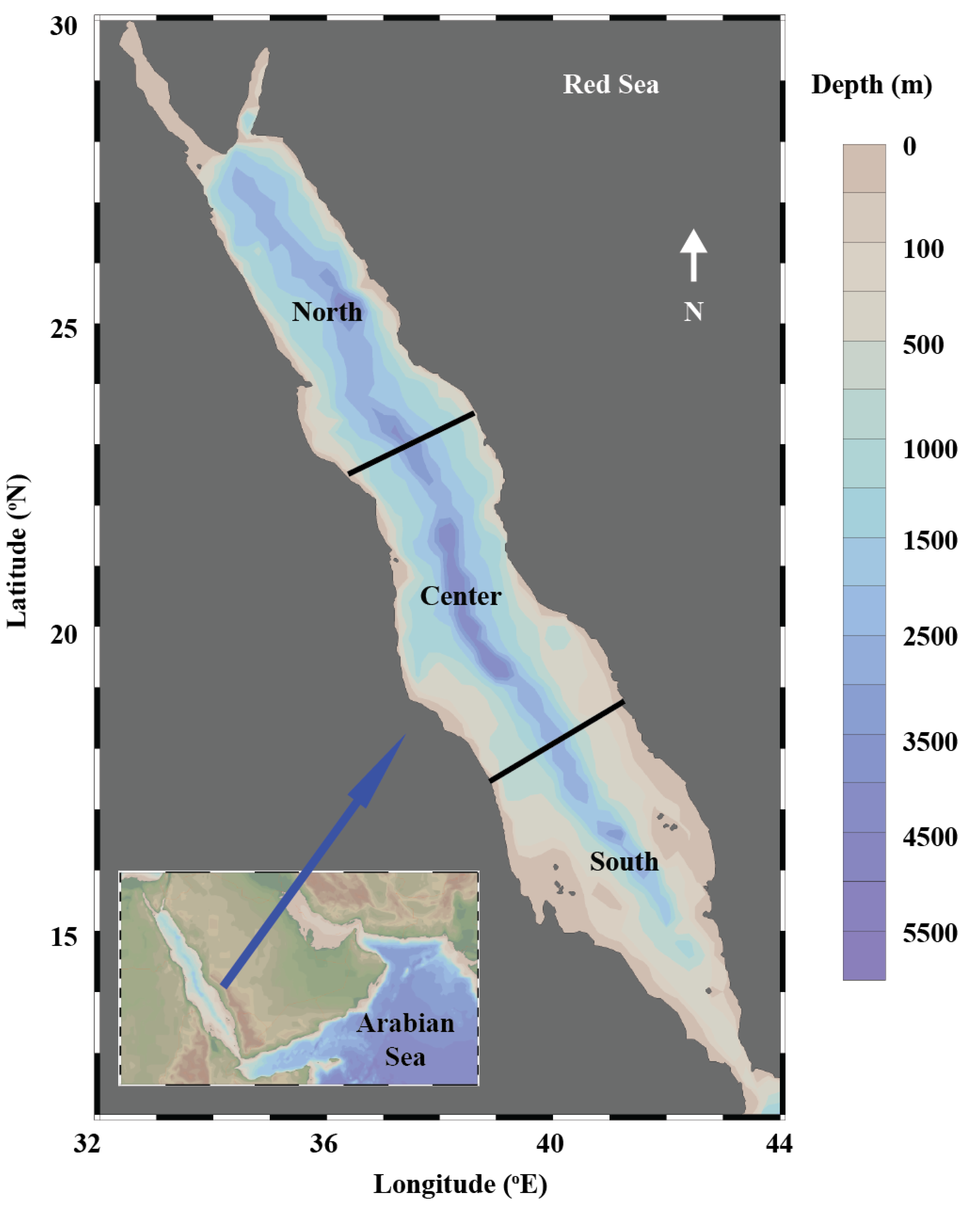

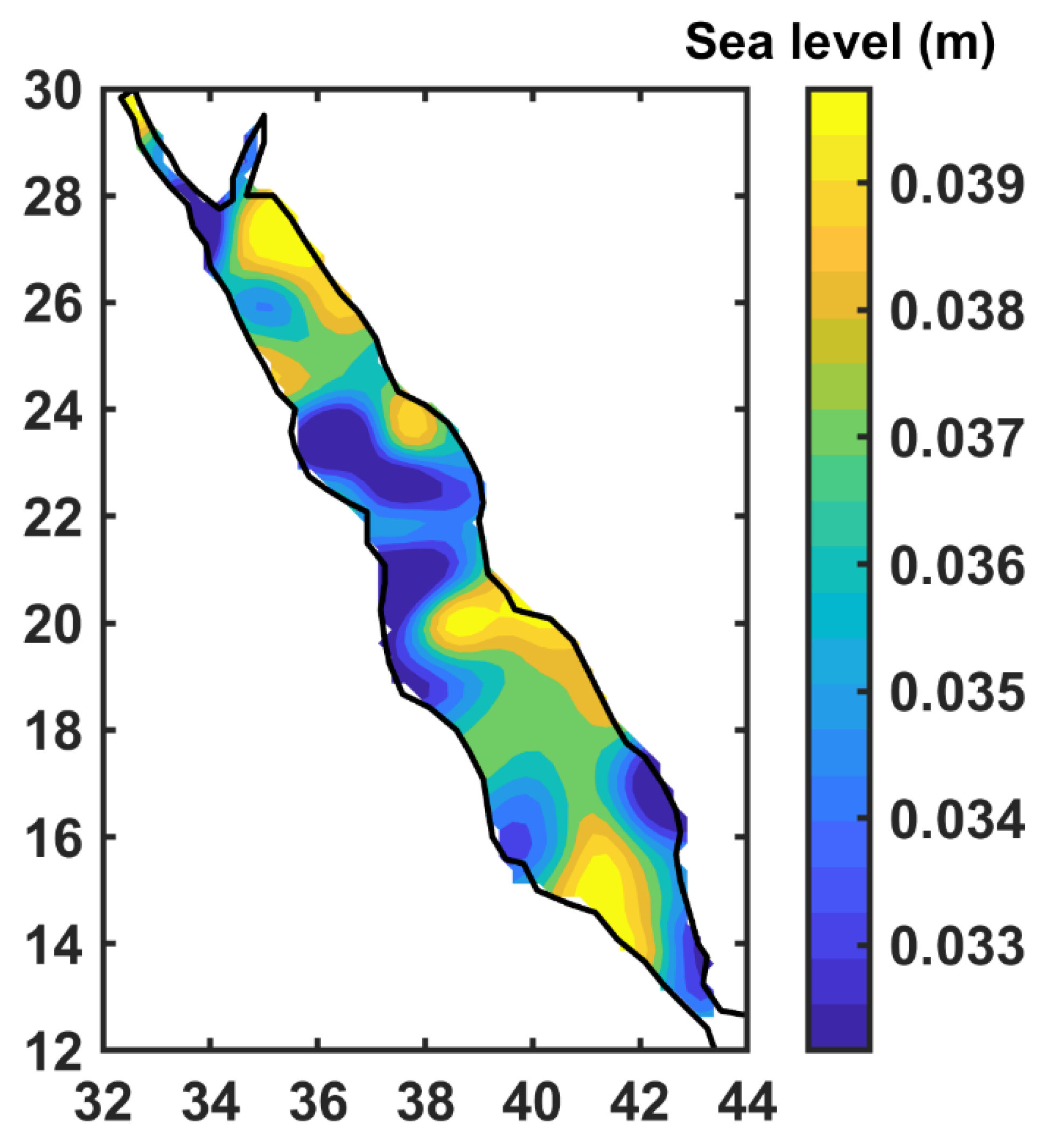

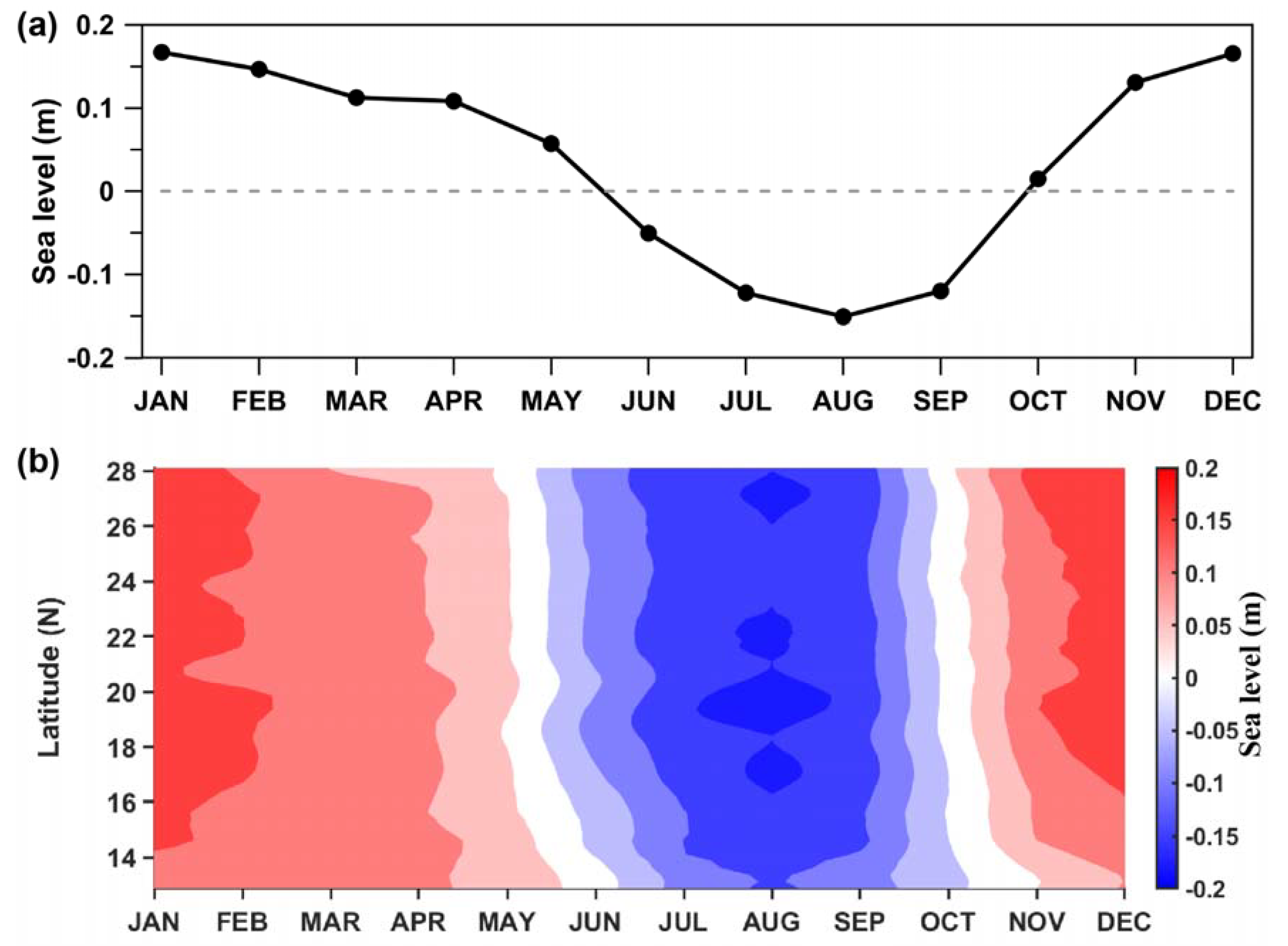
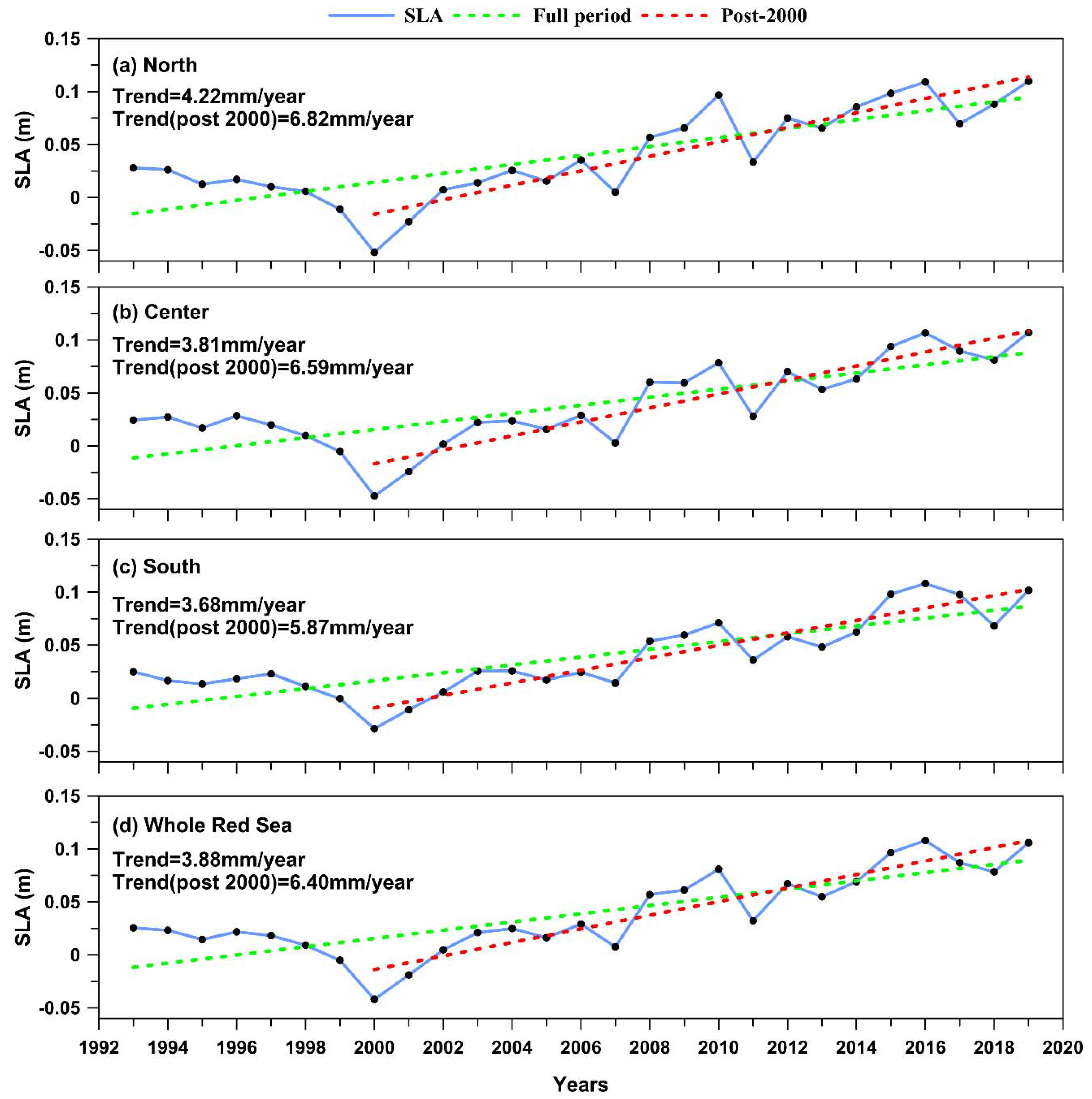
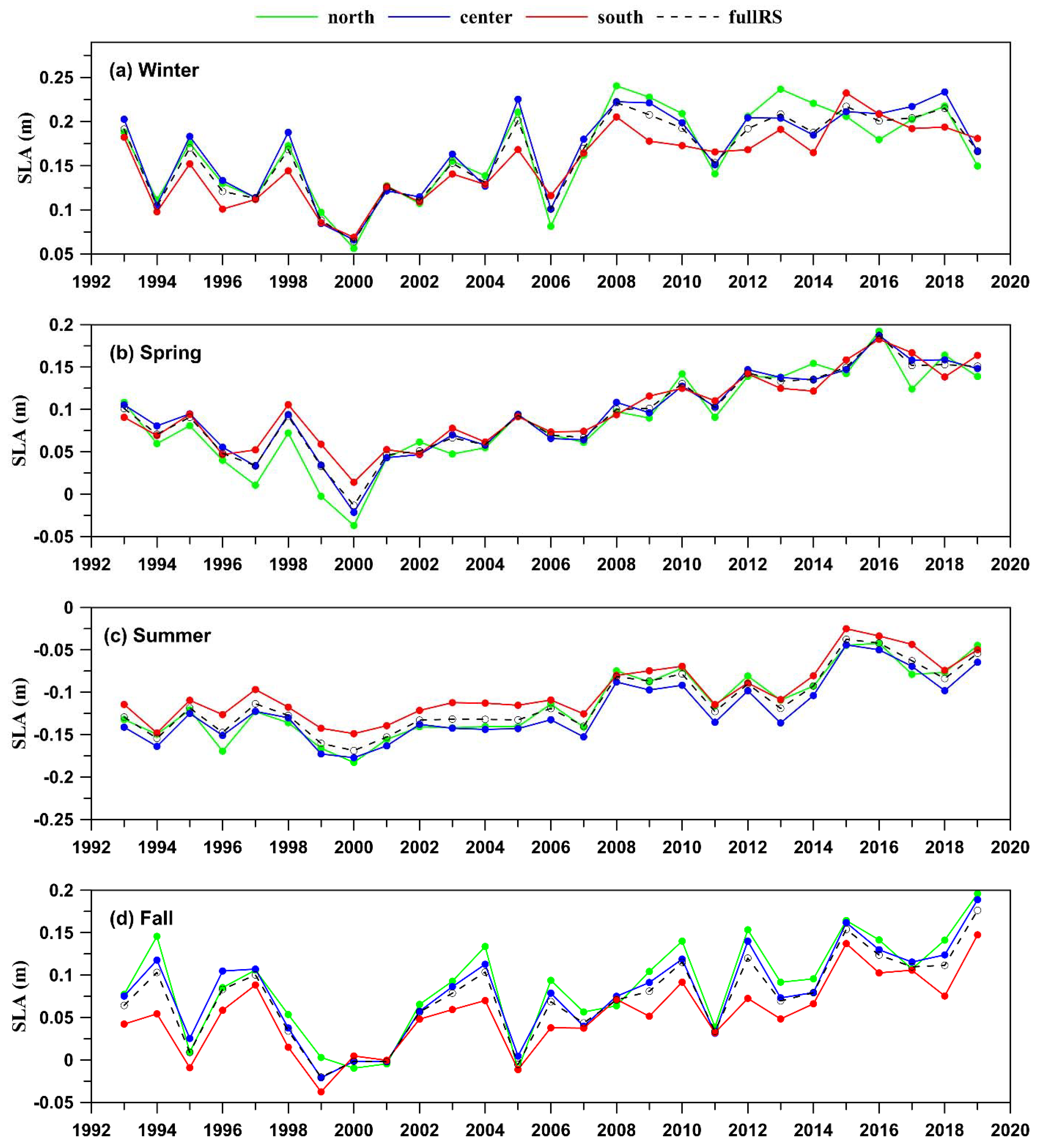


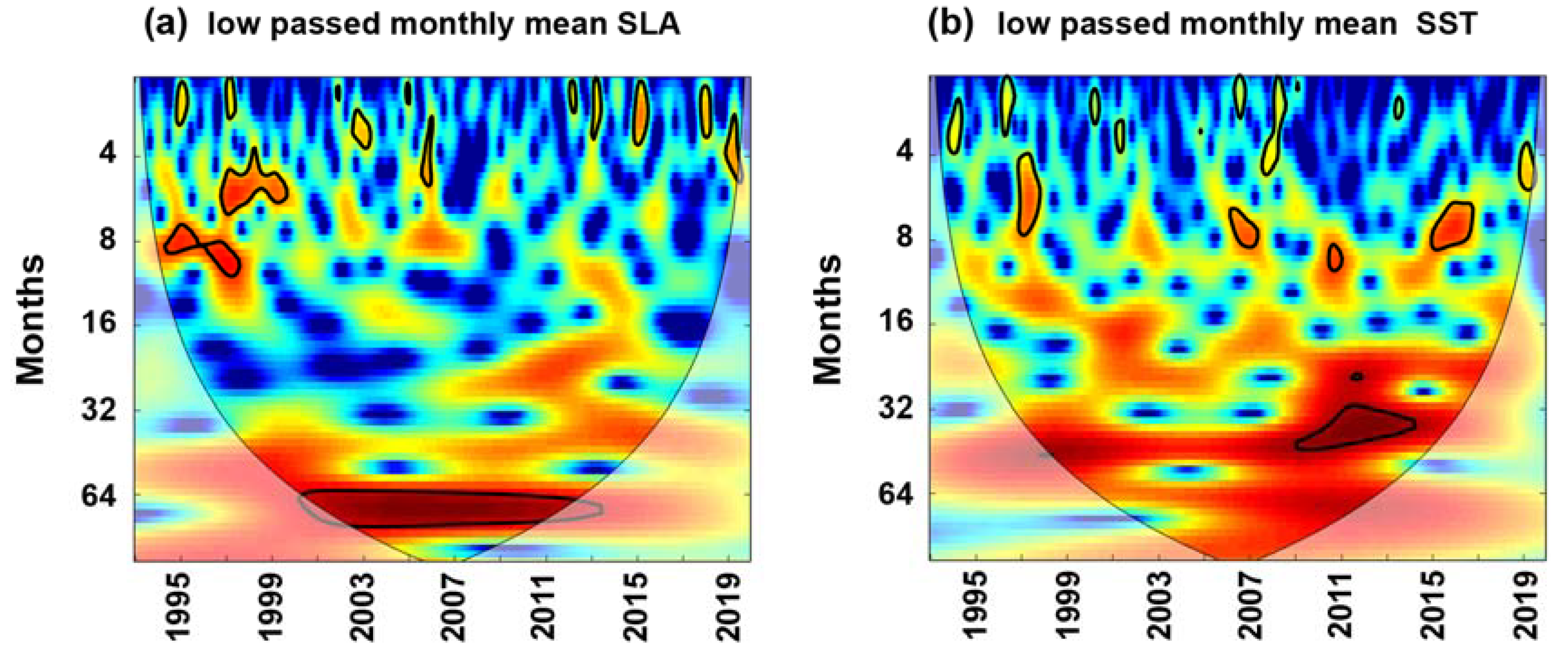
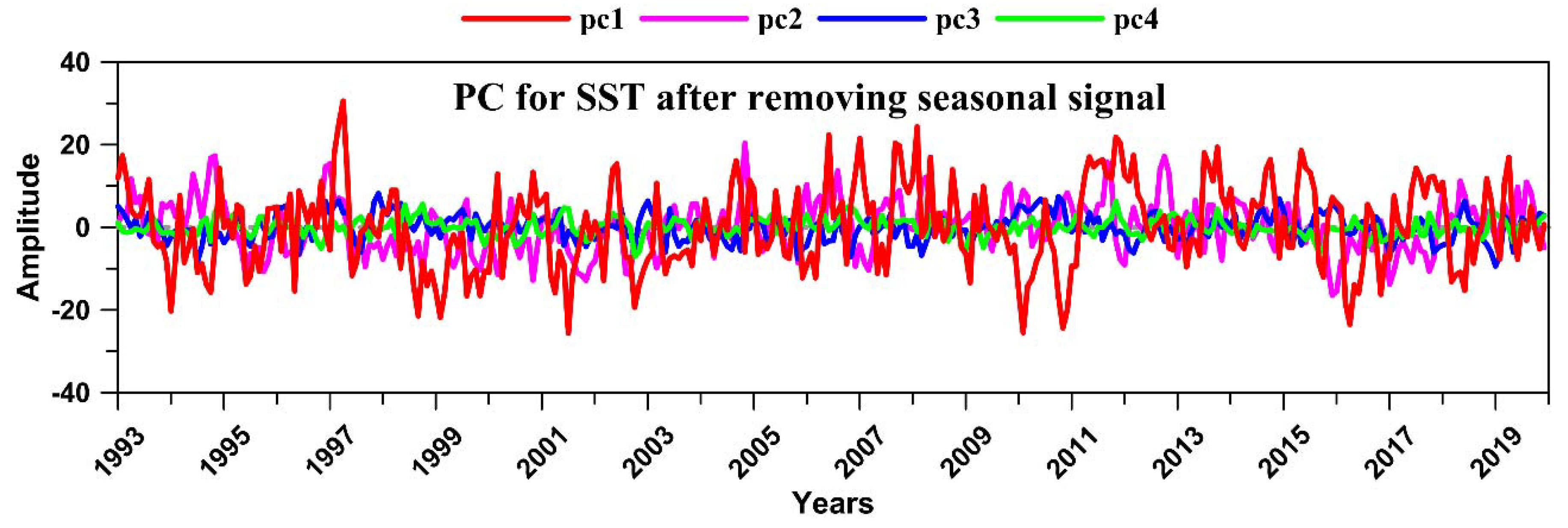
| No. | Station | Latitude (°N) | Longitude (°E) |
|---|---|---|---|
| 1 | Jazan | 16.898 | 42.537 |
| 2 | Qunfuda | 19.123 | 41.072 |
| 3 | Jeddah | 21.573 | 39.109 |
| 4 | Yanbu | 24.146 | 37.934 |
| 5 | Duba | 27.563 | 35.543 |
| SL No. | Stations | R | p-Value | Bias | RMSE |
|---|---|---|---|---|---|
| 1 | Jazan | 0.82 | 0 | 0.05 | 0.1 |
| 2 | Qunfuda | 0.85 | 0 | 0.08 | 0.12 |
| 3 | Jeddah | 0.85 | 0 | 0.07 | 0.12 |
| 4 | Yanbu | 0.85 | 0 | 0.09 | 0.13 |
| 5 | Duba | 0.81 | 0 | 0.09 | 0.13 |
| Basin | Sea-Level Trend (mm/Year) | |
|---|---|---|
| Full Period | Post-2000 | |
| Arabian Sea | 3.16 | 4.57 |
| Bay of Bengal | 4.15 | 3.40 |
| East-Pacific | 2.22 | 4.55 |
| West-Pacific | 3.23 | 2.09 |
| Atlantic | 2.82 | 2.40 |
| Red Sea | 3.88 | 6.40 |
| Years | SST (°C) | SLA (m) | ||||
|---|---|---|---|---|---|---|
| RCP2.6 | RCP4.5 | RCP8.5 | RCP2.6 | RCP4.5 | RCP8.5 | |
| 2020 | 25.243 | 25.141 | 25.023 | 0.439 | 0.464 | 0.429 |
| 2050 | 25.371 | 25.413 | 26.605 | 0.502 | 0.469 | 0.531 |
| 2100 | 25.311 | 26.298 | 27.624 | 0.591 | 0.633 | 0.775 |
| El-Nino | La-Nina | ||||
|---|---|---|---|---|---|
| Weak | Moderate | Strong/Very-Strong | Weak | Moderate | Strong/Very-Strong |
| 2004–2005 | 1994–1995 | 1997–1998 | 2000–2001 | 1995–1996 | 1998–1999 |
| 2006–2007 | 2002–2003 | 2015–2016 | 2005–2006 | 2011–2012 | 1999–2000 |
| 2014–2015 | 2009–2010 | 2008–2009 | 2020–2021 | 2007–2008 | |
| 2018–2019 | 2016–2017 | 2010–2011 | |||
| 2017–2018 | |||||
Publisher’s Note: MDPI stays neutral with regard to jurisdictional claims in published maps and institutional affiliations. |
© 2021 by the authors. Licensee MDPI, Basel, Switzerland. This article is an open access article distributed under the terms and conditions of the Creative Commons Attribution (CC BY) license (https://creativecommons.org/licenses/by/4.0/).
Share and Cite
Abdulla, C.P.; Al-Subhi, A.M. Is the Red Sea Sea-Level Rising at a Faster Rate than the Global Average? An Analysis Based on Satellite Altimetry Data. Remote Sens. 2021, 13, 3489. https://doi.org/10.3390/rs13173489
Abdulla CP, Al-Subhi AM. Is the Red Sea Sea-Level Rising at a Faster Rate than the Global Average? An Analysis Based on Satellite Altimetry Data. Remote Sensing. 2021; 13(17):3489. https://doi.org/10.3390/rs13173489
Chicago/Turabian StyleAbdulla, Cheriyeri P., and Abdullah M. Al-Subhi. 2021. "Is the Red Sea Sea-Level Rising at a Faster Rate than the Global Average? An Analysis Based on Satellite Altimetry Data" Remote Sensing 13, no. 17: 3489. https://doi.org/10.3390/rs13173489
APA StyleAbdulla, C. P., & Al-Subhi, A. M. (2021). Is the Red Sea Sea-Level Rising at a Faster Rate than the Global Average? An Analysis Based on Satellite Altimetry Data. Remote Sensing, 13(17), 3489. https://doi.org/10.3390/rs13173489





